The CrossFit Open 2020 has come to an end. For the vast majority of us regular CrossFit athletes, this may seem like a dead end but it’s actually meant to be a crossroad. No, we’re not going to the CrossFit Games (shocker) but we too have our work cut out for us.
The Open: a crossfitter’s SATs
We could argue that the Open is the big test we face every year. 5 weeks, 5 tasks and 5 scores that determine the level of our fitness relative to our coworkers, athletes at our box or pretty much any form of categorization you came up with using the personalized hashtags.
What to do with this information?
Well let’s try to give it some use, shall we? Lest we forget that one of the main teachings in the Sport of Fitness is that we are to measure, evaluate and repeat. The measuring phase was completed through the Open so now is the time to evaluate the results. ¿How can we use this data to help plan out the rest of the year? With a wonderful thing called SWOT Analysis.
What is the SWOT Analysis?
SWOT Analysis was created by Albert Humphrey back in the 60s and, since then, it’s become one of the most famous instruments in strategic planning for corporations.
SWOT is an acronym formed by the words “Strengths”, “Weaknesses”, “Opportunities” and “Threats” and during the analysis we evaluate each component individually to help a future decision-making process.
Internal analysis: weaknesses and strengths
At this stage we focus on individual elements that give us a competitive edge (strengths) as well as those that hinder our performance (weaknesses). These may be:
- specific movements: ring muscle-up, handstand walk, clean & jerk, etc.
- specific time domains: short and intense or long and grueling
- personal attributes: self-confidence, risk perception, insecurity, etc.
External analysis: threats and opportunities
Now’s when we dive into situational elements that may affect our athletic performance, both positively and negatively. A potential “threat” can be any kind of life event that can cause stress or any other negative emotional response (breakup, work-related issues, …); and an “opportunity” can be any chance to capitalize our strengths or work on weaknesses: local competitions, specialty courses, monostructural WODs, etc.
SWOT Matrix
All these elements are introduced in a SWOT matrix which would look like this:

In the threat department the goal is to identify them correctly and manage these situations. Increased work-related stress and a breakup will undoubtedly change our emotional affect, which will ultimately influence our performance. We can’t change these situations but we sure can change the way we respond to them.
When it comes the weaknesses it’s time to bite the bullet and let our ego take the hit. Constantly being humbled by pullup or handstand progressions can take its toll on our self-confidence but it’s important we stay on that path for however long it takes.
Give your strengths the role they deserve. If you have a weapon of choice, might as well keep it close. It does no good to unlearn something you’re proficient with just to boost other abilities so keep working on your strengths (especially on those days when nothing seems to go your way – it’ll keep your motivation high)
Seize the opportunities! Luckily, there’s plenty of situations where we can prove our worth or improve our current fitness levels; take advantage of it! Think of it as follow-up evaluations.
… start getting Open-ready for next year

It’s never too soon to start revving the engine for the big test. If you’re of the procrastinating kind (like myself), it’s better to start laying out a plan now that the Open results are still fresh. Jot down that SWOT Analysis, set up some building blocks for your goals and rest assured you’ll see the improvements in next year’s Open.
